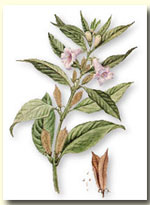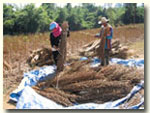| |
GROWING & HARVESTING
 Sesame seeds grow on a plant that has a hairy single stalk, though some do have branches. The average plant grows 2-4 feet high, some even up to 9 feet in height. The plant blossoms with white, pink or purplish flowers that develop into elongated pods containing numerous seeds stacked horizontally, one on top of the other, within the pod. The pear-shaped seed itself is encased in a fibrous hull that offers a range of color from light tan to red, brown and even black. Hulled seeds, those with the seed coat (hull) removed have an ivory color. Sesame is basically a crop of the tropics and subtropics, but newer cultivars have extended its range into more temperate regions. Sesame flourishes under tropical conditions, in the plains as well as up to an elevation of 400 ft. A temperature around 40 °C encourages rapid germination and flower formation. Temperatures above 40 °C and below 20 °C normally delays germination and seedling growth, but temperature below 10 °C inhibits both. Approximately 90 to 150 frost free days are required, and a hard frost at maturity kills the plant. Depending on the species, sesame plant requires 500-1000 mm of rainfall when grown in the autumn and an equivalent amount of water when grown in the spring. Sesame seeds grow on a plant that has a hairy single stalk, though some do have branches. The average plant grows 2-4 feet high, some even up to 9 feet in height. The plant blossoms with white, pink or purplish flowers that develop into elongated pods containing numerous seeds stacked horizontally, one on top of the other, within the pod. The pear-shaped seed itself is encased in a fibrous hull that offers a range of color from light tan to red, brown and even black. Hulled seeds, those with the seed coat (hull) removed have an ivory color. Sesame is basically a crop of the tropics and subtropics, but newer cultivars have extended its range into more temperate regions. Sesame flourishes under tropical conditions, in the plains as well as up to an elevation of 400 ft. A temperature around 40 °C encourages rapid germination and flower formation. Temperatures above 40 °C and below 20 °C normally delays germination and seedling growth, but temperature below 10 °C inhibits both. Approximately 90 to 150 frost free days are required, and a hard frost at maturity kills the plant. Depending on the species, sesame plant requires 500-1000 mm of rainfall when grown in the autumn and an equivalent amount of water when grown in the spring.
 Sesame is cultivated 80-150 days after sowing, most commonly 100-110 days and the average yield is 1.25 tons per hectare. The crop is harvested before the plants are completely dry because this prevents shattering of the capsules holding inside the seeds. The plants are cut and piled in bundles for drying for about a week on the threshing floor. Threshing can be done easily by shaking the plants or beating them lightly over a piece of cloth. In fact, harvesting is done manually and it is until recently that mechanization was introduced due to the uneven ripening of the sesame plant. After many researches, horticulturists developed a hybrid variety of sesame that does not scatter, and now some of he harvesting is a machine process, though too costly to be widely used. Sesame is cultivated 80-150 days after sowing, most commonly 100-110 days and the average yield is 1.25 tons per hectare. The crop is harvested before the plants are completely dry because this prevents shattering of the capsules holding inside the seeds. The plants are cut and piled in bundles for drying for about a week on the threshing floor. Threshing can be done easily by shaking the plants or beating them lightly over a piece of cloth. In fact, harvesting is done manually and it is until recently that mechanization was introduced due to the uneven ripening of the sesame plant. After many researches, horticulturists developed a hybrid variety of sesame that does not scatter, and now some of he harvesting is a machine process, though too costly to be widely used.
|

